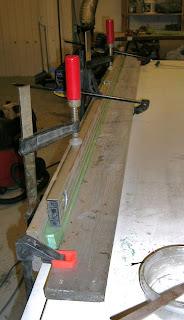Today I spent a lot of time sanding this layer down, but now I feel more confident the mould will be good again for the next rudders. And I'm in the progress of ordering some heavy duty release agents for the mast build, and I'll use this for the rudders as well. That way the moulds will hopefully live for another two rudders. It was the stupid spray glue that killed them in the first place anyway. No pictures of the progress. I wrapped up by putting both halves away for a while, I'll pick up the rudder build after my vacation.
I've been working on the travellers. The design calls for a carbon based traveller support for the bridging boomless main traveller. I'm adding a self tacking jib traveller on my own expense. I'm not sure why Farrier does not have a self tacking jib as a standard, it seems to me that should be standard on any safe, comfortable family cruiser. But anyway, I've been spending some time trying to figure out the best way to solve this. There are a few conflicting areas: I'd like to provide for the largest possible non-overlapping jib. I'd like to maintain the trailability of the boat, thus not blocking the daggerboard slot. I'd like a low profile deck arrangement that does not prevent safe movement on deck. I've been trough a moulded in-deck profile in front of the daggerboard slot via a hinged traveller solution allowing easy removal for trailering but I have settled on a solution where a bridge style carbon based traveller passes between the mast foot and the raised daggerboard, only needing removal for mast foot removal. It will be supported by one carbon support each side and provide for the biggest possible non-overlapping jib. Then the question curved or straight. Jib tracks have a history of being curved, the curve being a percentage (=<100) of the JLP, where every designer and sail-maker seems to have their own one and only correct curve calculator. Newer designs seems to work well with a straight traveller (Seaon 96), possibly because of the better traveller cars available. I'll do none of the above. No specific reason, just felt like it was time to stop speculating and make things happen. It will be curved, slightly larger radius than the JLP, the thought is the sheet is being slightly eased as the sail passes the centreline for light air tacking. Details of the supports are not yet figured out but I expect things will be clear as the process goes on. Unfortunately the mast foot is not available as I had to return it for some adjustments, ie to be as specified in plans (after waiting for it to be finished for a year and a half or so...).
I will be using a low profile track, the track support being a foam cored carbon structure with aluminium tapping plate embedded.
Foam routed back and aluminium tapping plate fitted.
The traveller support blank. To be adjusted to final dimensions using electrical planer and then a mixture of unidirectional and biaxial carbon fibres will cover the structure to make it very rigid.
The view straight north as I was leaving the workshop at 0:25 am last night. I live on the peninsula under the sunny part, around 5 km (3 miles) from the workshop. I'm sure that distance cost me at least a year in launching date compared to be able to work at home.
The daggerboard control lines and the mast foot itself is limiting factors in placing the traveller, so it is being cut back to the thinnest possible in the mid section, almost only allowing the track ,tapping plate and supporting carbon fibres to pass the centre line. The finished laminate was wrapped in peel ply and packaging tape being applied from centre and out each side, before being supported and put under pressure.
The main traveller (as the rest of the boat) is made according to plans
Foam blank being kept straight as the aluminium tapping plate is being embedded.
Putty filling around the aluminium. Trimmed to specs. To be rounded and laminated.














2 comments:
About the jib, we use an overlapping jib on the 18-footer skiff , I guess around 25-30 cm. You can do this if a short batten is added above the clew. Also a long batten going to the tack can be used, makes a nice shape then reaching. I can send you a photo if you like. The jib traveller is about 2 cm in front of the mast. In light winds you need to ease the jib just a bit to make it pass the mast during tack. Sheet is going forward with some floating blocks/fixed blocks on the foredeck then aft to both sides. I sheet it by hand no trouble, I guess the F22 jib is no bigger than the 18 foot skiff.
All the best
Martin F
Hi Martin! Thanks for your comments. My jib will be around 10m^2. Overlapping will be good, and I will not have spreaders to conflict while tacking. I have been looking at the Gran glider jib (http://www.gransegel.se/glider.html), with one long curved batten.
I would very much appreciate pictures of the jib arrangements on your skiff. I'm in the process of ordering hardware right now, that is a lot of work. Seems like it will be a Ronstan dominance, and I'm thinking of the series 19 for the jib, not perfectly clear to me what to do with the sheet leads yet except they will be going forward and back on each side. I'd like to add controls to be able to back the jib and heave to as well.
Where are you located? I will be based at Blåvand second week of August.
Post a Comment